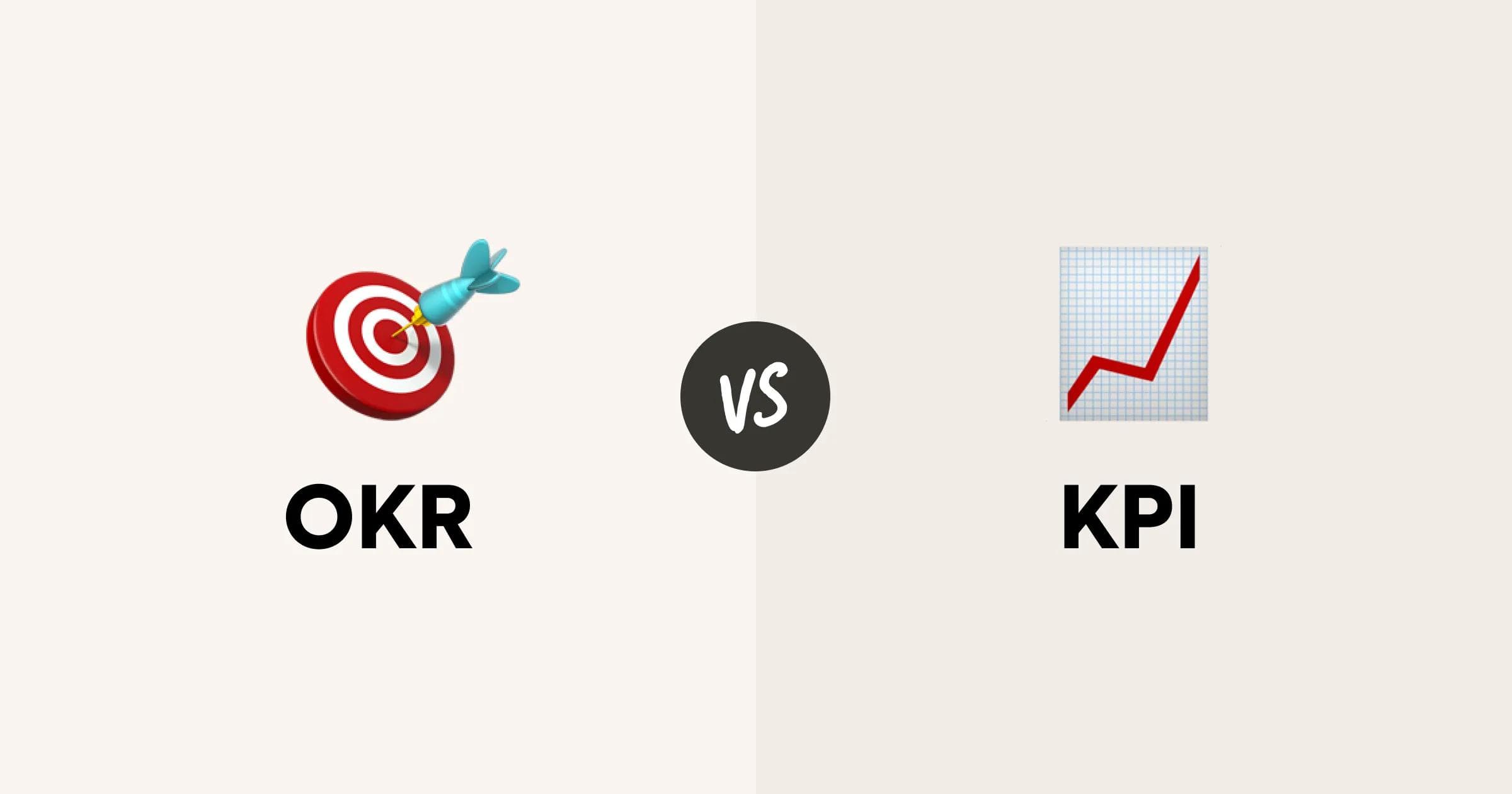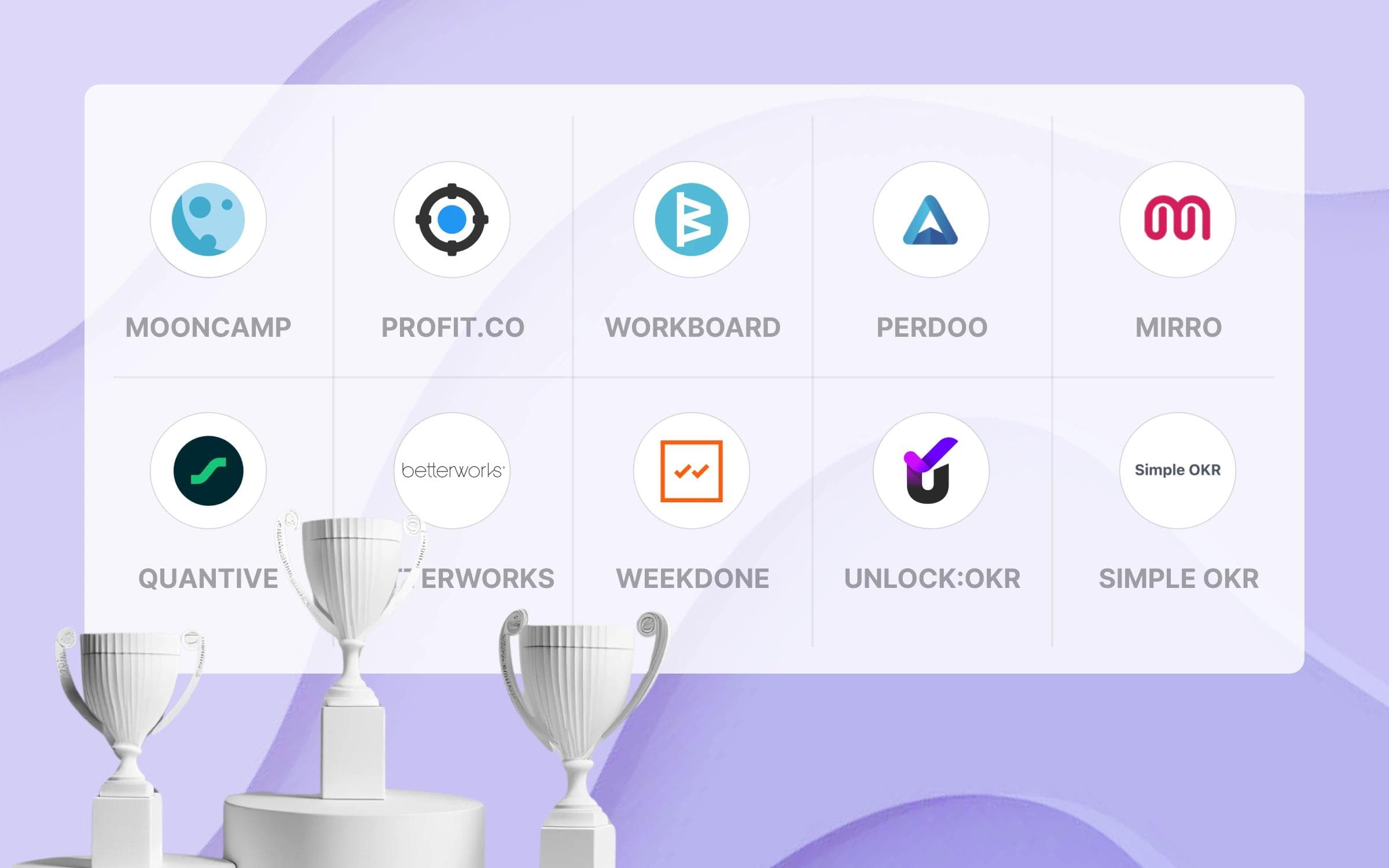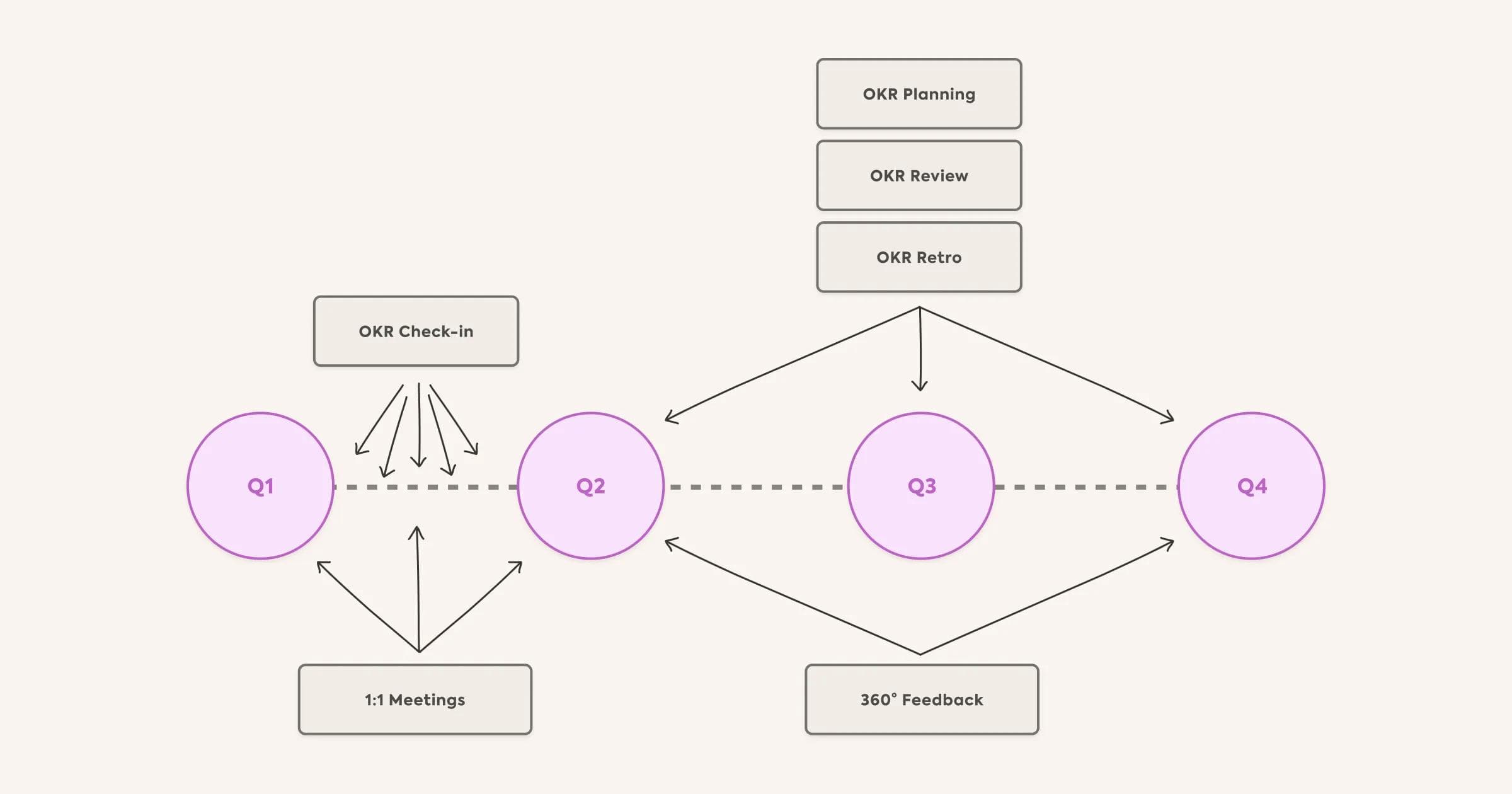- The confusion: People treat OKRs and KPIs as competing systems - they're actually complementary. KPIs are your dashboard gauges; OKRs are your destination coordinates
- KPIs as triggers: When your churn rate KPI spikes, that's the signal to create an OKR like "Reduce customer churn from 8% to 4%." KPIs reveal problems; OKRs solve them
- Key distinction: KPIs are lagging indicators (measuring what happened). Key Results should be leading indicators (measuring what you can directly influence this quarter)
- Practical tip: Key Results can contain KPIs ("Increase NPS to 50"), but not all KPIs need OKRs. Only create OKRs when a KPI signals need for change
OKR and KPI are often seen as competing and interchangeable concepts.
When introducing OKRs, employees therefore frequently ask themselves how they differ from existing KPIs in the company.
Yet the difference between OKRs and KPIs is actually quite simple to explain.
In a nutshell:
OKRs (Objectives and Key Results) are goals that are focused on driving change. Objectives are inspiring, qualitative goals that are linked to measurable goals, the Key Results.
KPIs (Key Performance Indicators), in turn, are metrics that measure the status quo or past performance of an organization. Key Results can include KPIs in their phrasing, but they don't have to, as the figure below shows.
As we all know, a picture is worth a thousand words:
Below, we explain the terms OKR and KPI in more detail and highlight their differences using various examples.
Finally, we address the interplay between OKRs and KPIs, as the two terms are often misunderstood as competing approaches. However, they can actually create much more value for your team or organization when used in combination than on their own.
OKRs vs KPI - Definition
What are KPIs?
Key performance indicators (KPIs) are metrics that measure the performance of an organization. They can be seen as health metrics of the company, showing a snapshot or the past development of performance.
Examples of KPIs
- Turnover
- EBITDA
- Number of customers
- Marketing costs
- Number of resignations per year
"Key" here is the literal keyword that is often disregarded: It implies that you should focus only on the metrics that really matter. What is important is determined by the company's strategy.
So instead of getting lost in tons of metrics, companies (or departments or teams) should settle on a handful of key performance indicators. If your company ends up identifying 50 or 100 "KPIs" you've basically gained nothing. On the contrary, unclear priorities and company-wide confusion will be the result.
What are OKRs?
OKR is a goal management framework and stands for Objectives and Key Results. Objectives are qualitative goals and are what I want to have achieved or what I am working towards. Key Results are quantitative goals that answer how I am achieving the qualitative Objectives. So, in contrast to KPIs, OKRs are always associated with a goal or desired change, while KPIs are focused on the past and present.
Objective | Key Result |
|---|---|
What do I want to achieve? | How do I know that the goal is reached? |
Characteristics
| Characteristics
|
By having a maximum of 3-5 Key Results per Objective, formulating Objectives in an inspiring and motivating way, and using clearly measurable and time-bound Key Results, the three "superpowers of OKRs" are unleashed:
- Focus: Limiting the number of OKRs forces you to focus on the things that really matter
- Alignment: By setting team OKRs that align with company-level OKRs, all employees, teams and departments have the same overarching goal in mind - everyone is pulling in the same direction
- Transparency: OKRs are shared publicly with all teams, so every employee knows where the company stands right now
Example of an OKR:
Objective: We delight our customers
Key Results:
- Achieve an NPS of at least 42
- Increase CSAT score to at least 75%
- Decrease Ø response time to customer service inquiries to 30 minutes
Each of the Key Results above includes a KPI (in bold).
In summary: OKRs, unlike KPIs, are thus always focused on a goal and aim to change the status quo.
OKR vs KPI - Overview
OKR | KPI |
|---|---|
Objectives & Key Results | Key Performance Indicators |
Ambitious & qualitative goals (Objectives) linked to quantitative goals (Key Results) that measure progress towards Objectives | Health metrics that measure operational excellence or performance |
Future-oriented and goal-driven; strive for change | Consider the status quo or past performance of metrics |
Are ambitious, inspiring, and motivating | Are assessment-based and, in the case of negative development, can trigger targeted measures or OKRs |
Are time-bound (e.g. half-year, quarter, …) | Are measured permanently and are often more long-lasting than OKRs |
Transparent and accessible to all | Communication via management |
Are set up both top-down by management and bottom-up by teams | Are typically set by management |
OKR vs KPI - Illustrated with the example of a trip to the moon 🚀
Visual examples help to better remember the differences between KPI and OKR, as well as explain them to other colleagues and peers. We love - for obvious reasons - all about moon metaphors and examples 🌝
That's why we want to introduce you to the differences between OKR and KPI using the example of a space mission to the moon.
KPIs for a trip to the moon
The cockpit of a manned rocket sent to the moon provides a number of KPIs, such as:
- Current velocity
- Ø Speed
- KM traveled
- KM to destination
- Payload capacity ( baggage ) in tons
- Ø Fuel consumption
- Remaining fuel
With these metrics, the crew can see at a glance how fast the rocket is moving and how much fuel is left. So we are only looking at performance or health metrics of the rocket. They tell us nothing about the actual mission, or how that mission is to be achieved.
That's what we have OKRs for.
OKRs for a trip to the ISS and the moon
OKR examples for a space mission could be to send a manned rocket to the ISS or even to establish a base on the moon. Both goals have different requirements for KPIs. For example, to reach the moon, the rocket needs a higher terminal velocity than if it only had to fly to the ISS space station. Similarly, to build a moon base you need a higher payload ("more baggage").
🔬 Objective: We fly to the ISS to renew laboratory materials
Key Results:
- Achieve a terminal rocket velocity of 7.9 km/s
- Achieve a payload capacity of at least 10 tons
🚀 Objective: We are going to the moon to build the first moon base
Key Results:
- Achieve a terminal rocket velocity of 11.2 km/s
- Achieve a payload capacity of at least 45 tons
(We are not rocket scientists, so don't nail us down on the exact values 👀)
The above example illustrates that KPIs can be formed into Key Results in the context of a mission or a specific goal. The above Key Results could be goals of a research team that has the task to design a corresponding rocket - here the strategy and the goal are the main focus. The cockpit of the rocket, on the other hand, shows the crew the current KPIs or performance metrics - here the focus lies on controlling and monitoring.
OKR vs KPI - Leading indicators vs lagging indicators
In most cases, KPIs are so-called lagging indicators, while OKRs must always be leading indicators. What does this mean exactly?
Lagging indicators are KPIs whose measurement is only possible with a time lag. Typical financial lagging indicators are revenue, cash flow, profit margin or market share. These key figures can therefore only be influenced indirectly and are the result of previous activities.
On the other hand, there are leading indicators: They describe metrics that can be directly measured and influenced. Since key results are usually tied to short 3-month or 4-month cycles, the use of lagging indicators would make no sense here, because at the end of the cycle you would have no feedback on whether you were successful or not. For this reason, you look at leading indicators whose progress you can measure immediately or only with a short delay.
Therefore, the challenge in formulating Key Results is to find a metric whose change is measurable within the OKR cycle and has a sufficiently strong link to the relevant lagging indicator (such as revenue).
How it all comes together: KPIs, OKRs and strategy
Imagine you were tasked with deciding on your company's future strategy.
First, you wade through a sea of possible metrics (for financials, customers, employees, operational processes, etc.) that you want to use to describe the "health" and performance of your business.
You search until you've identified a handful of performance metrics that sit right at the root of the business. At the same time, you make sure that they illuminate the company's performance from different perspectives (see also the MECE principle). Voilà - you have found your Key Performance Indicators.
In a highly simplified model, your " company cockpit" might now look like this:
In this example, we can see that KPIs can even be triggers for OKRs and your wider business strategy. While sales and customer loyalty have a positive development, the churn rate of employees can be considered critical.
As a result, OKRs could be created for the next cycle with the goal of reversing this negative trend. An example might look like this:
Objective: We create a great workplace
Key Results:
- Achieve an eNPS of at least 40
- Reduce voluntary turnover in Q3 by 30%
- Reduce the number of complaints in the workplace from 9 to 3
OKRs vs KPI – Conclusion
OKRs and KPIs work perfectly together. KPIs help monitor performance and identify problems and areas for improvement. OKRs help solve problems, improve processes, and drive innovation. Tracking KPIs and OKRs in parallel not only keeps you on top of things at all times, but also keeps you aware of all the moving parts of your business that teams and employees need to execute the business strategy.
We hope this article has made it clear that KPIs and OKRs can only develop their full potential in interplay. So it's not "either-or", but "both".
What is the difference between OKR and KPI?
OKRs (Objectives and Key Results) are goals that drive change. Objectives are inspiring qualitative goals that are linked to measurable targets, the Key Results. KPIs (Key Performance Indicators), in turn, are metrics that measure the status quo or past performance of an organization. Key Results can include KPIs in their formulation, but they don't have to.
Which is better: OKRs or KPIs?
OKRs and KPIs work perfectly together. KPIs help monitor performance and identify problems and areas for improvement. OKRs help solve those problems, improve processes, and drive innovation. Thus, KPIs often point to the areas where OKRs should drive change.
Can OKRs replace KPIs?
No. KPIs are used to monitor the performance and health of an organization. OKRs, on the other hand, are used to drive change. However, the two concepts can be married fruitfully by turning developments in KPIs into catalysts for new OKRs.





